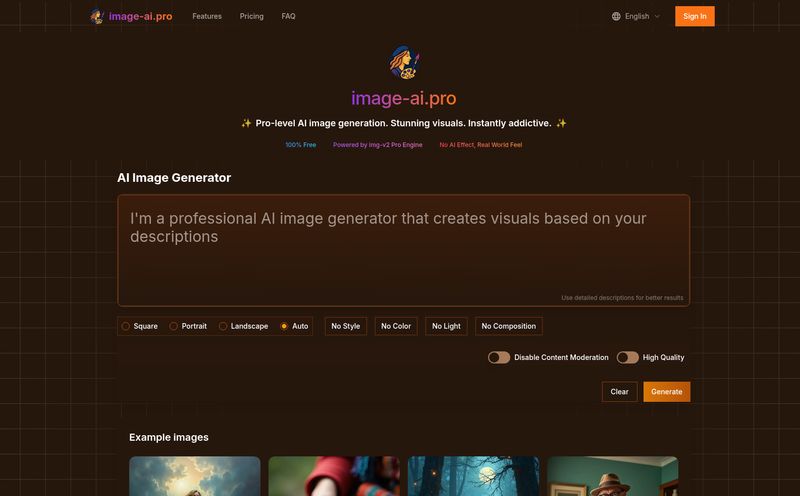It feels like just yesterday we were all collectively losing our minds over the first wave of AI image generators. You know the ones. You'd type in "a photorealistic cat riding a skateboard" and get back a seven-legged feline melting into a board with eighteen wheels. It was magical, hilarious, and just a little bit cursed.
We've come a long, long way since then. The AI art gold rush is in full swing, with big names like Midjourney and Stable Diffusion dominating the conversation. But every so often, a new contender steps into the ring that makes you sit up and pay attention. For me, that new contender is DeepFloyd IF.
This isn't just another flavor-of-the-month model. It’s a completely different approach, one that seems to solve one of the most frustrating problems in AI art: understanding what we actually mean. Especially when it comes to text. So, grab a coffee, and let's talk about whether this thing is the real deal.
What Exactly is DeepFloyd IF? A Look Under the Hood
Alright, so what makes DeepFloyd tick? Unlike many models that work in a more abstract, latent space (a fancy way of saying a compressed, mathematical representation of an image), DeepFloyd IF works directly with pixels. It uses a clever method called cascaded pixel diffusion.
Think of it like an artist sketching. First, the model generates a tiny, 64x64 pixel rough draft based on your prompt. It's the basic idea, the core composition. Then, a second module takes that sketch and upscales it, refining it into a much clearer 256x256 image. Finally, a third super-resolution module takes that image and blows it up to a crisp 1024x1024 final piece. Each step adds detail and clarity. It's a bit like a three-stage rocket, where each stage pushes the image to a higher level of quality.

Visit DeepFloyd IF
But the real secret sauce, in my opinion, is its brain. DeepFloyd uses a massive text encoder called T5-XXL-1.1. This is what reads your prompt. Because its text understanding is so robust, it's leagues better at interpreting complex sentences, spatial relationships (like "a red cube on top of a blue sphere"), and, most impressively, rendering actual, legible text within an image. This has been the holy grail for a while, and DeepFloyd gets remarkably close.
And the best part? It's open-source. It lives on GitHub, free for anyone to inspect, modify, and build upon (with some license caveats we'll get to later).
Getting Your Hands Dirty with DeepFloyd IF
So, you want to try it out? This is where things get a bit... technical. This isn't a slick web app or a Discord bot. You'll need to head over to its GitHub repository and follow the setup instructions. It involves a bit of command-line action and installing it via `pip`. You’ll also need to accept the model’s license on its Hugging Face page before you can download the weights.
But before you even open your terminal, we need to talk about the elephant in the room: the hardware. DeepFloyd IF is a hungry, hungry beast. To run the full pipeline, from the base image to the final 1024px output, you're going to need a GPU with at least 16GB of VRAM, and honestly, 24GB is a much safer bet. This isn't something you'll be running on your 5-year-old laptop. This is serious hardware for serious users.
The Good Stuff: Unbelievable Photorealism and Text Rendering
Once you clear the hardware hurdle, the magic begins. The level of photorealism is staggering. But the true game-changer, and I don't use that term lightly, is its ability to write. You can ask for a sign that says "Danger: AI at Work" and it will actually... write that. The letters are coherent. The spacing is right. It's not perfect every time, but compared to the garbled nonsense other models produce, it’s a revelation.
Beyond that, it has some incredible built-in features like:
- Zero-shot Image-to-Image: You can give it an image of a cat and ask it to turn it into a tiger, without any special training.
- Super Resolution: That cascaded model I mentioned can be used on its own to upscale your existing low-res images.
- Zero-shot Inpainting: This is my favorite. You can mask out a part of an image and just tell the AI what to put there. It's like Photoshop's Content-Aware Fill got a Ph.D. in linguistics. Imagine removing an ex from a photo and telling the AI to replace them with "a photorealistic slice of pizza." The power.
The Not-So-Good Stuff: Hurdles and Headaches
I wouldn’t be a good blogger if I didn't give you the full picture. DeepFloyd IF is amazing, but it's not without its drawbacks. That VRAM requirement is the biggest barrier to entry, full stop. It immediately prices out a huge chunk of the hobbyist community.
The setup process, while straightforward for a developer, can be a maze if you're not comfortable with Python environments and package installers. And finally, there's the license. Initially, the model was released under a research-only license, meaning you couldn't use it for commercial projects. These things change fast in the open-source world, but it's crucial to check the current license on the model's Hugging Face page before you decide to build a business around it.
DeepFloyd IF vs. The Competition
So how does it stack up against the titans? It's all about trade-offs.
| Model | Best For | Biggest Hurdle |
|---|---|---|
| DeepFloyd IF | Prompts with text, complex scenes, high control. | Massive hardware (VRAM) requirements. |
| Stable Diffusion | Community support, custom models (LoRAs), runs on consumer GPUs. | Struggles with text and complex prompt anatomy. |
| Midjourney | Ease of use, beautiful artistic styles out-of-the-box. | Closed-source, less precise control, subscription cost. |
In my book, they all have their place. Midjourney is the artist's quick-and-easy tool. Stable Diffusion is the tinkerer's paradise. DeepFloyd IF is the specialist's instrument for when precision and language matter most.
What About the Cost? Is DeepFloyd IF Free?
This is a question that needs a nuanced answer. The software itself, the code on GitHub, is free to download and use (per its license). But running it is another story.
The real cost is twofold:
- Compute Cost: You need that powerful GPU. You either buy one (which can cost thousands of dollars) or you rent one from a cloud service like Google Colab, Vast.ai, or AWS. These services charge by the hour.
- Platform Cost: The code is hosted on GitHub. For personal or open-source use, GitHub is free. But if you're a team looking to build a private, commercial application using this model, you'd likely need a paid GitHub plan like their 'Team' or 'Enterprise' tiers, which cost $4 and $21 per user/month, respectively. These plans give you private repositories, advanced security features, and other tools essential for professional development.
So yes, the model is 'free' like a puppy is free. The initial acquisition is easy, but the long-term care and feeding will cost you.
My Final Thoughts and Who This is For
I'm genuinely excited about DeepFloyd IF. It's not just an incremental improvement; it's a leap forward in a specific, and very important, direction. It feels like we're finally getting closer to an AI that doesn't just see pixels but understands concepts.
Who is this for right now?
- AI Researchers pushing the boundaries of what's possible.
- Developers who want to build applications that need reliable text generation.
- AI artists with a powerful home setup who crave more precise control over their creations.
Who should probably wait?
- Casual users and hobbyists without a monster GPU.
- Anyone who wants a simple, plug-and-play experience. You're still better off with Midjourney or a simple Stable Diffusion web UI for now.
DeepFloyd IF is a glimpse of the future. A powerful, demanding, and slightly inconvenient future. For now, it's a tool for the pros and the deeply dedicated, but I have no doubt its innovations will trickle down and become the standard for all models soon enough.
Frequently Asked Questions about DeepFloyd IF
- What's the biggest advantage of DeepFloyd IF over Stable Diffusion?
- Without a doubt, its text comprehension and ability to render legible text within images. Its powerful T5 text encoder allows it to understand complex prompts much more accurately.
- Do I need to be a programmer to use DeepFloyd IF?
- Right now, yes, some comfort with the command line, Python, and tools like GitHub is pretty much essential. It's not a user-friendly app yet.
- How much VRAM do I really need?
- For the full experience including the 1024px upscaler, you need at least 16GB of VRAM. The creators and community strongly reccomend 24GB for smoother performance. You can run just the base model with less, but you'll miss out on the high-resolution magic.
- Can I use DeepFloyd IF for commercial projects?
- This is critical: you must check the license. It was initially released with a restrictive, research-only license. While this may have changed, always verify the current terms on the Hugging Face model page before using it for any commercial purpose.
- Is DeepFloyd better than Midjourney?
- They're different tools for different jobs. If you want beautiful, artistic images with minimal fuss, Midjourney is fantastic. If you need precise control, complex scenes, or text in your image, DeepFloyd is the superior choice, assuming you can handle the technical setup.
Conclusion
In the breakneck race of AI development, DeepFloyd IF has carved out a unique and powerful niche. It’s not the easiest tool to use, and its hardware demands are steep, but its ability to understand and render language is a monumental achievement. It's a reminder that we're still in the early days of this technology, and the most exciting developments are likely still ahead of us. It's not a 'Stable Diffusion killer' just yet, but it's a brilliant specialist that shows us exactly where the game is headed.
Reference and Sources
- Official DeepFloyd IF GitHub Repository
- DeepFloyd on Hugging Face (for model weights and license)
- Stability AI (The organization behind DeepFloyd)
- GitHub Pricing Page (For context on platform costs)



